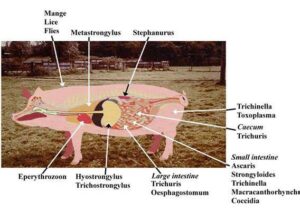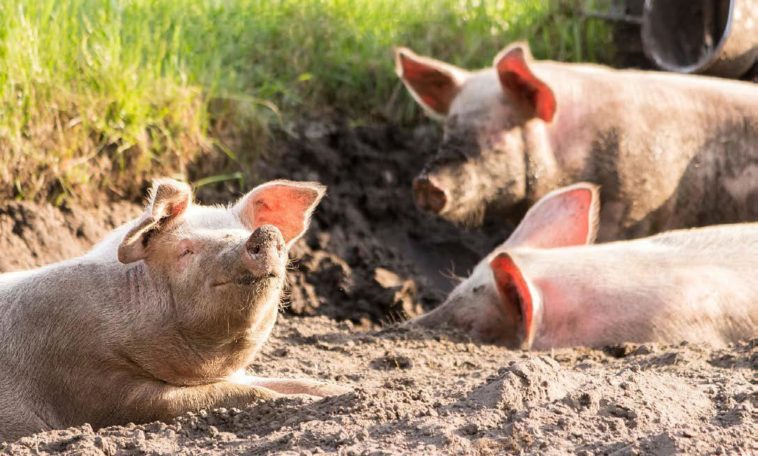Prevention is better than cure. Nowhere is this statement more accurate than used in reference to animal health. Medicines are expensive and they often influence the production schedule because of the half-life of the medicines.
During this period, animals cannot be slaughtered for human consumption because the active ingredients of the medicine are still present in the meat.
In order to understand what causes disease in animals, we first need to know what disease is. Disease (also known as sickness) is any process that interferes with the way the different parts of the body work and look. We do not normally consider injuries such as broken legs and cuts as diseases.
Causes of disease in animals
There are many causes of disease in animals. Knowledge of what causes disease, and of how animals can get a disease, helps us to know how to prevent disease and to treat sick animals. Below are some potential causes of disease.
Parasites
Parasites are organisms that have to live on or in other organisms, such as animals, in order to survive. Most parasites are easy to see, although some mites and the early stages of worms can only be seen under a microscope.
Some of the biggest threats to animal health can be found in the smallest bacteria that infect your animals. Keeping the housing facilities clean, stringent bio-security measures and sound hygienic practices will help you to protect your animals from infection. Photo: Pixabay.com.
External parasites
Flies, lice, fleas, ticks and mites can cause serious diseases in animals. Some live on the animals for their entire lives, others only spend part of their lives there, while others only visit to feed. They can result in irritation and skin damage in animals. Some parasites can also pass diseases such as redwater and three-day stiffsickness between animals.
Internal parasites
Internal parasites (including roundworms, flukes and tapeworms) can cause serious diseases and loss of production in animals. They usually live in the stomach and intestines but also in other parts of the body such as the lungs and liver.
Microbes (germs)
Microbes (germs) are usually too small to be seen with the naked eye, and only a microscope will enable you to see what a microbe looks like. Just because you do not see microbes with your naked eye, does not mean that they cannot cause disease in your animals. Some microbes are harmless.
For example, bacteria surround animals and people, and they even live on our skin and inside our nose, mouth and stomach, but these bacteria do not normally cause problems. Some microbes are even helpful, such as the ones in our gut which help us to digest food.
Many different microbes can cause disease in animals, but there are four main types:
Viruses
Viruses are the smallest of all microbes. They must live inside cells in order to survive and breed. Viruses cause about 60% of disease outbreaks in animals and humans. Examples of diseases in animals caused by viruses are rabies, Newcastle disease and three-day stiffsickness. It is difficult
to treat diseases caused by viruses because the viruses live inside animal cells. Therefore, any medicine that can kill the viruses will also harm the animals in which the viruses are present.
Bacteria
Bacteria can live in animals and in the environment. Not all bacteria cause disease. People and animals have bacteria living on and in them that do not cause disease. Examples of diseases in animals caused by bacteria are anthrax, blackquarter and tuberculosis. Bacteria can infect wounds, and that is why wounds should be treated.
Fungi
Fungi occur widespread in the environment (soil, air and water) and include mushrooms and mould on stale food. Fungi need to grow on organic material in order to feed, and this can include animals and people. An example of a fungal disease in animals is ringworm. Some fungi are normally harmless, but can cause disease in some situations, especially after prolonged use of antibiotics. Some fungi can also produce toxins or poisons which can be a problem when food becomes stale or wet.
Protozoa
Some protozoa can live outside cells, especially the type that causes trichomonosis, a venereal disease in cattle. Others need to live inside cells, and include those causing coccidiosis, redwater, heartwater and gallsickness.
Poisoning
Animals can be poisoned by chemicals (such as insecticides and dips), poisonous plants and fungal toxins. They can also be bitten by snakes, scorpions and spiders.
Dietary problems
Lack of enough food or lack of a particular part of the food (such as phosphorus) can also cause disease. Malnourished animals may develop other diseases because they are weak.
Metabolic diseases
Metabolic diseases are an upset in the normal functioning of the animal (that is not caused by infection, poisoning or feed deficiencies) and usually result from intensive animal production. An example is milk fever in highly-productive dairy cows.
Congenital diseases
In some cases, animals can be born with a disease. Some of these may be inherited (passed on from the parents). This is rare, and inherited diseases are usually seen at birth. An example is congenital hydrocephalus, which is a swelling of the brain caused by fluid, and can be clearly seen as a swelling of the head.
Environmental diseases
Environmental problems, such as pollution, contribute to some diseases, for example, animals may eat plastic bags or wires and this can harm the animal’s health.
Cancer
Cancer occurs when some of the cells in the body grow in a way that is different from normal. Illness occurs because of the pressure of the growth on other parts of the body and the fact that affected parts of the body cannot function normally. Cancer can also cause signs such as fever and loss of condition. In some instances, viruses can cause cancer.

This diagram illustrates disease-causing parasites and in which areas of the pig’s body they can be found. Acknowledgement to www.carrsconsulting.com.
Allergies
Some diseases are caused by allergies, which is when the body’s own immune system attacks part of the body.
Degenerative disease
Some diseases are caused by parts of the body breaking down, particularly as an animal grows older.
How to prevent disease
Good management, which includes good hygiene and sufficient feed, can reduce the chances of animals getting disease. In some cases, vaccination and practices such as dipping and deworming can also prevent disease.
We thank the South African Department of Agriculture for the information provided to the readers of Botswana, Namibia and Zimbabwe in this article series. For more information visit their website at https://www.daff.gov.za/.









